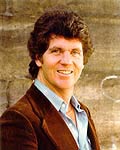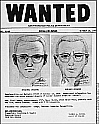I have NEVER seen so many Zynchronicities in one man's Biography!! I discovered this, quite by accident, researching certain connections between Stanford University and student productions of The Mikado.....and found this.
I AM NOT saying he was The Zodiac nor do I fully believe he "fits" the profile but sure is a lot! SoCal, Bay Area, Communications/code training, a year on a merchant marine ship in the orient in 1965-66, Army Training, Journalism Education/background, Job as an Editor, Actor, Writer and, of course, The Mikado Connection.
He was in a Stanford Production of The Mikado (As a company player in the Stanford Repertory Theatre Group) in 1966 and featured it in the climactic finale of his first "Hollywood" movie, "Foul Play".
Colin was, as Avery deduced," a latent homosexual".
Colin Higgins died in Los Angeles in 1981 from complications of AIDS.
Colin Higgins was born in Noumea, New Caledonia, a French island in the Pacific, to Joy Kelly Higgins, an Australian, and John Edward Higgins, an American. He attended school in Oakland, California, and later in Sydney, after his family moved to Australia in 1950. He graduated with honors in 1958 from his high school, St. Anthony's College in Robertson, New South Wales, and the following year he enrolled in Stanford University, where he became interested in theater and wrote and acted in several student productions. In 1960, after his freshman year, he hitchhiked to New York, where he worked as a page at ABC television and studied acting at the Actors Studio. In 1962, after a second year at Stanford, he enlisted in the army, and upon graduating from the Armed Forces Communications School at Fort Slocum, New York, he was assigned to work as assistant editor on the 2nd Division Bayonet at Fort Benning, Georgia. He was assigned overseas in 1963 and traveled throughout Europe as a journalist with the 8th Division Arrow and Stars and Stripes. Following his discharge in 1965, he studied for six months at the Sorbonne in Paris and made his film acting debut in Louis de Funes's Le Gendarme à New York (1965). Returning to Stanford in 1966 to study creative writing under Wallace Stegner, Higgins worked nights as a professional actor with the Stanford Repertory Theatre at the Comedia Repertory Company in Palo Alto. He also appeared in his first American film, as an extra in Petulia (1968). After graduating from Stanford in 1967 with a B.A. degree, he signed on as an ordinary seaman on a merchant ship bound for the Orient, and for six months he toured Japan, Hong Kong, and the South Pacific. Later in 1967 he entered graduate school at UCLA to study film and continue his acting career. In 1969 the Student Theatrical Society voted him Best Actor of the Year at UCLA for his performance in the title role of The Importance of Being Earnest. Also at UCLA he made two student films: Opus One, a satire on student films, and Retreat, which won grand prize at the Long Beach film festival. As a graduate assistant in his last year at UCLA, he taught courses in beginning film and studio production, and the University of Minnesota invited him to judge their of Media Festival. His master's thesis, a screenplay entitled Harold and Maude, won second prize in the annual Samuel Goldwyn Awards. After receiving his M.F.A. degree in 1970, Higgins formed his own production company and made a deal with Paramount Pictures to produce the film with Hal Ashby directing.
Harold and Maude, the bizarre story of a love affair between a young man, Harold (Bud Cort), and an elderly woman, Maude (Ruth Gordon), who are brought together by their mutual fascination for death, funerals, and suicide, was not an immediate success in the United States, probably because of its offbeat humor. Although it was not received well critically or at the box office, it did attract a strong following on college campuses, and critics soon labeled it a cult film. Its appeal to students and young people seems to lie in its rejection of the establishment values represented by Harold's wealthy and domineering mother--who tries to get him to drive a sports car instead of a hearse, to go with the "right" girls she has selected for him, and to try to make something of himself--and by the military, represented by Harold's uncle, a hawkish, one-armed general. Finding conventional values absurd, Harold repeatedly stages mock suicide attempts. Harold finds Maude, who is seventy-nine years old and plans to commit suicide on her eightieth birthday, invigorating and falls in love with her. Though heartbroken by her suicide, he is converted to her love of life and learns to accept it--but on his own terms.
Despite its relative failure in the United States, Harold and Maude was instantly successful in France, running in one movie house for more than two years. At the urging of Jean-Louis Barrault, Higgins adapted his screenplay for the stage. Translated by the French playwright-screenwriter Jean-Claude Carrière, the play opened successfully in Paris in 1972 and ran for more than four years. It has since been produced in the United States, Germany, Japan, Spain, Argentina, Czechoslovakia, England, and Canada. Higgins also expanded the screenplay into a novel, which was published in 1971 and has been translated into a half-dozen foreign languages.
While in Paris, Higgins joined Peter Brook's international theater group as playwright-in-residence, and with English playwright Dennis Cannon he collaborated on a stage adaptation of Colin Turnbull's book The Mountain People. The play, The Ik, was translated by Jean-Claude Carrière and on 12 January 1975 opened successfully as Les Iks in Brook's theater in Paris. In 1976 it was produced in London, and also in 1976 the French government, as a bicentennial gift, sponsored a tour of The Ik throughout the United States.
Higgins's next two films, Silver Streak (1976) and Foul Play (1978), are marked by their similarity to earlier Hollywood movies. Both are derivative celebrations of the old-fashioned suspense thrillers that audiences have enjoyed for years. Films of form rather than content, they are slick, fast-paced adventure-comedies meant to thrill and entertain. Both were big box-office hits.
Originally entitled "Super Chief", Silver Streak is about a man (Gene Wilder) who falls in love with another passenger (Jill Clayburgh) on a cross-country trip and is innocently caught up in mystery and intrigue. A sudden murder, strange disappearances, and steely-eyed villains lurking inside Pullman cars combine to recreate past moments of Hollywood films. Although criticized for being too derivative of older films, particularly North by Northwest,Silver Streak was one of the surprise successes of its year.
Higgins made his directorial debut with his next film, Foul Play. Most critics have pointed out Higgins's tribute to Alfred Hitchcock in this picture, particularly in the romance between the heroine (Goldie Hawn) and the police detective (Chevy Chase) assigned to protect her. Murders abound, bodies seem to disappear, and the heroine is chased, chloroformed, and kidnapped before she can convince the police that someone is out to get her.
The climactic scene in which the hero and heroine, trying to prevent the assassination of the Pope, chase through an opera house during a performance of The Mikado harkens back to Hitchcock's The Man Who Knew Too Much. There is even a humorous nod to Psycho with a spoof of its famous shower scene. Like Silver Streak, Foul Play received mixed reviews, but it was a financial success, so much so that it inspired a television series which ran briefly in 1980.
Higgins's next film, for which he rewrote a screenplay by Patricia Resnick, 9 to 5 (1980), became his biggest commercial success. The film, about three secretaries (Jane Fonda, Lily Tomlin, Dolly Parton) who conspire to get rid of their domineering, sexist boss (Dabney Coleman), was written by Resnick as a black comedy; the humor was to come from the secretaries' unsuccessful attempts to murder their boss. Higgins was asked to lighten the tone, and he changed the story so that the secretaries only fantasize about killing the boss. When one of the fantasies is nearly realized by accident, the secretaries kidnap the boss and then blackmail him. 9 to 5 was transformed into a television series in 1981.
The Best Little Whorehouse in Texas (1982), which Higgins adapted from the Broadway musical with the play's authors, Larry L. King and Peter Masterson, was Higgins's first nonoriginal screenplay and his first written in collaboration. The film and play are based on a well-known brothel in Texas, the Chicken Ranch, which operated for decades with the consent of the populace, becoming a virtual institution in the state. It was finally shut down when a television personality alleged that the Chicken Ranch had ties with organized crime. The film centers mostly on the romance (which was not in the play) between the sheriff (Burt Reynolds) and madam Mona Strangely (Dolly Parton). The sheriff does his best to save the Chicken Ranch, but it is finally closed when the governor discovers that a majority of voters want such an action. After the ranch is abandoned, the sheriff marries Miss Mona. Like earlier Higgins films, The Best Little Whorehouse in Texas received mixed, mostly poor, reviews but was a huge financial success.
With the possible exception of Harold and Maude, Colin Higgins's films are to a large extent about moviemaking, but they are more than remakes, serving commentary on the best techniques of American film. Higgins is one of a new generation of student filmmakers come of age--writers and directors who went to school to study the history of American cinema and filmmaking techniques. If his small body of work is a fair test, Colin Higgins learned his lessons well.
http://www.bookrags.com/biography/colin-higgins-dlb/
